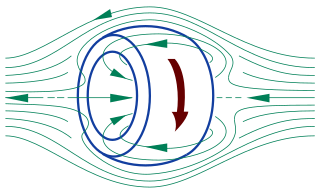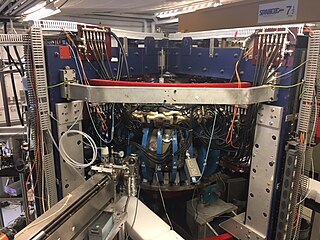
A tokamak is a device which uses a powerful magnetic field to confine plasma in the shape of a torus. The tokamak is one of several types of magnetic confinement devices being developed to produce controlled thermonuclear fusion power. As of 2016, it was the leading candidate for a practical fusion reactor. The word "tokamak" is derived from a Russian acronym meaning "toroidal chamber with magnetic coils".

Fusion power is a proposed form of power generation that would generate electricity by using heat from nuclear fusion reactions. In a fusion process, two lighter atomic nuclei combine to form a heavier nucleus, while releasing energy. Devices designed to harness this energy are known as fusion reactors. Research into fusion reactors began in the 1940s, but as of 2024, no device has reached net power.

Inertial electrostatic confinement, or IEC, is a class of fusion power devices that use electric fields to confine the plasma rather than the more common approach using magnetic fields found in magnetic confinement fusion (MCF) designs. Most IEC devices directly accelerate their fuel to fusion conditions, thereby avoiding energy losses seen during the longer heating stages of MCF devices. In theory, this makes them more suitable for using alternative aneutronic fusion fuels, which offer a number of major practical benefits and makes IEC devices one of the more widely studied approaches to fusion.

The Levitated Dipole Experiment (LDX) was an experiment investigating the generation of fusion power using the concept of a levitated dipole. The device was the first of its kind to test the levitated dipole concept and was funded by the US Department of Energy. The machine was also part of a collaboration between the MIT Plasma Science and Fusion Center and Columbia University, where another (non-levitated) dipole experiment, the Collisionless Terrella Experiment (CTX), was located.

Magnetic reconnection is a physical process occurring in electrically conducting plasmas, in which the magnetic topology is rearranged and magnetic energy is converted to kinetic energy, thermal energy, and particle acceleration. Magnetic reconnection involves plasma flows at a substantial fraction of the Alfvén wave speed, which is the fundamental speed for mechanical information flow in a magnetized plasma.

Magnetic confinement fusion (MCF) is an approach to generate thermonuclear fusion power that uses magnetic fields to confine fusion fuel in the form of a plasma. Magnetic confinement is one of two major branches of controlled fusion research, along with inertial confinement fusion.

A field-reversed configuration (FRC) is a type of plasma device studied as a means of producing nuclear fusion. It confines a plasma on closed magnetic field lines without a central penetration. In an FRC, the plasma has the form of a self-stable torus, similar to a smoke ring.

A spheromak is an arrangement of plasma formed into a toroidal shape similar to a smoke ring. The spheromak contains large internal electric currents and their associated magnetic fields arranged so the magnetohydrodynamic forces within the spheromak are nearly balanced, resulting in long-lived (microsecond) confinement times without external fields. Spheromaks belong to a type of plasma configuration referred to as the compact toroids. A spheromak can be made and sustained using magnetic flux injection, leading to a dynomak.

Alcator C-Mod was a tokamak that operated between 1991 and 2016 at the Massachusetts Institute of Technology (MIT) Plasma Science and Fusion Center (PSFC). Notable for its high toroidal magnetic field, Alcator C-Mod holds the world record for volume averaged plasma pressure in a magnetically confined fusion device. Until its shutdown in 2016, it was one of the major fusion research facilities in the United States.

The Plasma Science and Fusion Center (PSFC) at the Massachusetts Institute of Technology (MIT) is a university research center for the study of plasmas, fusion science and technology.

The Sustained Spheromak Physics Experiment (SSPX) is a program at Lawrence Livermore National Laboratory in the United States established to investigate spheromak plasma.
The polywell is a design for a fusion reactor based on two ideas: heating ions by concentrating (-) charge to accelerate the ions and trapping a diamagnetic plasma inside a cusp field.

The Magnetospheric Multiscale (MMS) Mission is a NASA robotic space mission to study the Earth's magnetosphere, using four identical spacecraft flying in a tetrahedral formation. The spacecraft were launched on 13 March 2015 at 02:44 UTC. The mission is designed to gather information about the microphysics of magnetic reconnection, energetic particle acceleration, and turbulence — processes that occur in many astrophysical plasmas. As of March 2020, the MMS spacecraft have enough fuel to remain operational until 2040.
ADITYA is a medium size tokamak installed at the Institute for Plasma Research in India. Its construction began in 1982, and it was commissioned in 1989. It was the first tokamak in India.

The Hybrid Illinois Device for Research and Applications (HIDRA) is a medium-sized toroidal magnetic fusion device housed in the Nuclear Radiation Laboratory and operated by the Center for Plasma-Material Interactions (CPMI) within the Department of Nuclear, Plasma and Radiological Engineering at the University of Illinois at Urbana–Champaign, United States. HIDRA had its first plasma at the end of April 2016 and started experimental campaigns by December of that year. HIDRA is the former WEGA classical stellarator that was operated at the Max Planck Institute for Plasma Physics in Greifswald Germany from 2001 to 2013.
Masaaki Yamada is a Japanese plasma physicist known for his studies on magnetic reconnection.
Troy Alan Carter is an American plasma physicist and a professor at the University of California, Los Angeles. He was co-awarded the 2002 John Dawson Award for Excellence in Plasma Physics Research for his work on driven magnetic reconnection in a laboratory plasma.

Ambrogio Fasoli is a researcher and professor working in the field of fusion and plasma physics. A Fellow of the American Physical Society, he is Director of the Swiss Plasma Center, located at EPFL, the Swiss Federal Institute of Technology in Lausanne, Switzerland. Since 1 January 2019, he chairs the European consortium EUROfusion, the umbrella organisation for the development of nuclear fusion power in Europe.

James Wynne "Jim" Dungey (1923–2015) was a British space scientist who was pivotal in establishing the field of space weather and made significant contributions to the fundamental understanding of plasma physics.
Fatima Ebrahimi is an Iranian-American physicist and inventor. She carries out theoretical and computational plasma physics research for applications including fusion energy and space and astrophysical plasmas.














